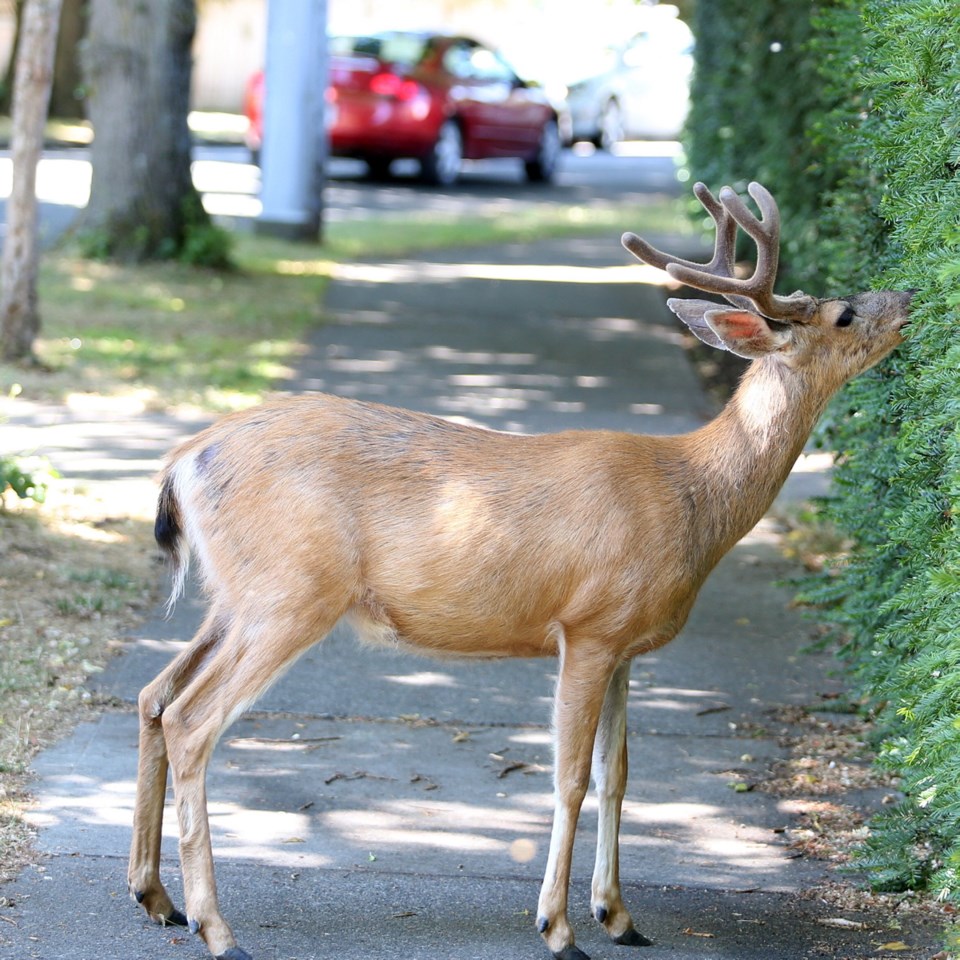As an ever-growing number of deer graze their way through Greater Victoria yards and gardens this summer, many local politicians are looking hopefully to the East Kootenay, where a $100,000 pilot program to relocate deer is underway.
“The objectives were to test translocation as a non-lethal alternative to culling of deer,” said wildlife biologist Ian Adams, whose Cranbrook-based VAST Resource Solutions is running the pilot, funded by conservation groups with help from the municipalities involved.
“We’re hesitant to use the ‘S’ word — success. But the initial results are very promising,” Adams said.
Sixty mule deer were caught in Kimberley, Cranbrook, Invermere and Elkford between February and mid-March in an effort to save, rather than cull them. The plan is to get those through one full year of post-release monitoring to see how they fare.
Out of the 60 deer, 29 were fitted with GPS radio collars that transmit the animals’ locations every 13 hours.
One of the concerns with relocation was that the citified deer would be “predator naïve” and easy pickings for predators, Adams said. “They’re used to sort of staring down threats from people and dogs and things and that strategy doesn’t work so well with wolves and cougars. So that was an initial concern.”
Adams said there have been eight mortalities to date — most by cougars, one by a suspected bear and one by a suspected wolf. That predation rate seems comparable to or slightly higher than predation rates on a similar project run concurrently by provincial biologists on non-urban mule deer in the East Kootenay, he said.
Since mid-May, some of the deer have found their way into more urban areas, said Adams, adding that while it’s too early to say for sure, it appears the deer might be moving to urban areas to fawn.
“It’s almost as if that was their safe zone where they want to fawn. That’s what they are used to. They were fine, initially — we had very wide-ranging movements. Some moved very little and others moved hundreds of kilometres.”
In fact, he said, if there was a surprise, it was in the distance some of the deer have travelled — something that could be a limiting factor for trying translocation on the Island.
The deer were originally moved onto winter range areas in the East Kootenay 2 1/2 to three hours’ drive from where they were captured.
“We wanted to get them 100 kilometres from their home community and preferably 30 kilometres or so from any other community. From the outset, the province was very adamant that [while] we were translocating deer, we were not translocating the problem,” Adams said.
“That distance criteria that we had from communities didn’t ultimately mean a whole lot. So that seems to be one of the issues we need to address. What happens when these deer find their way into other communities and some sort of strategies in dealing with that.”
Previously, the province had been reluctant to look at translocation as an option for urban deer. Mule deer, in particular, are easily stressed during capture and mortality rates were historically high.
But Adams said the East Kootenay project went “really well.”
“We had very good success with the handling and moving. There are some newer drugs that we were sedating and immobilizing the deer with.”
In the capital region, Oak Bay has taken the lead in trying to manage urban deer.
Since 2013, the Capital Regional District and Oak Bay have spent a combined $270,000 for two deer-management pilot projects — one in Central Saanich and one in Oak Bay. Eleven deer were killed last year in Oak Bay’s cull, which divided the community and prompted protests. Since then, a citizens’ group has advocated using a contraception vaccine called SpayVac as an alternative to any future cull.
Oak Bay Mayor Nils Jensen said his municipality is not planning to engage in a deer-management program this year. The municipality has set aside about $20,000 and council asked staff to “bring forward some ideas about canvassing our community as to what they see as the way forward,” he said. “We are hearing more voices out there that want something done about reducing the population.”
Jensen said Oak Bay is keen to see the results of the relocation pilot project in the East Kootenay, and whether the province allows the program in other parts of the province. “That might be an option, but again, for a number of councillors, this comes down to cost.”
In Victoria, Mayor Lisa Helps said she hardly gets any complaints about deer.
But while there is no accurate count of the number of urban deer in the region, Coun. Chris Coleman said it would be wrong to think problems with deer aren’t on the rise.
He notes that a doe matures at two or three years, then typically gives birth to twins each year for 10 or more years.
Experts say that in urban areas, where deer eat well and are not hunted by humans or other predators, a deer herd will grow exponentially — doubling in size every three years.
“As the numbers grow, they start foraging for more food … and people start losing their crops, their flowers and whatever as the damage becomes greater. I’m hearing more and more [complaints] now, just on the grumbling side.
“Usually by August or September, it’s reached a height. So we’re back into the cycle,” said Coleman, who has long advocated setting up a deer farm — something that is done in New Zealand, which he says exports $267 million worth of venison every year.



